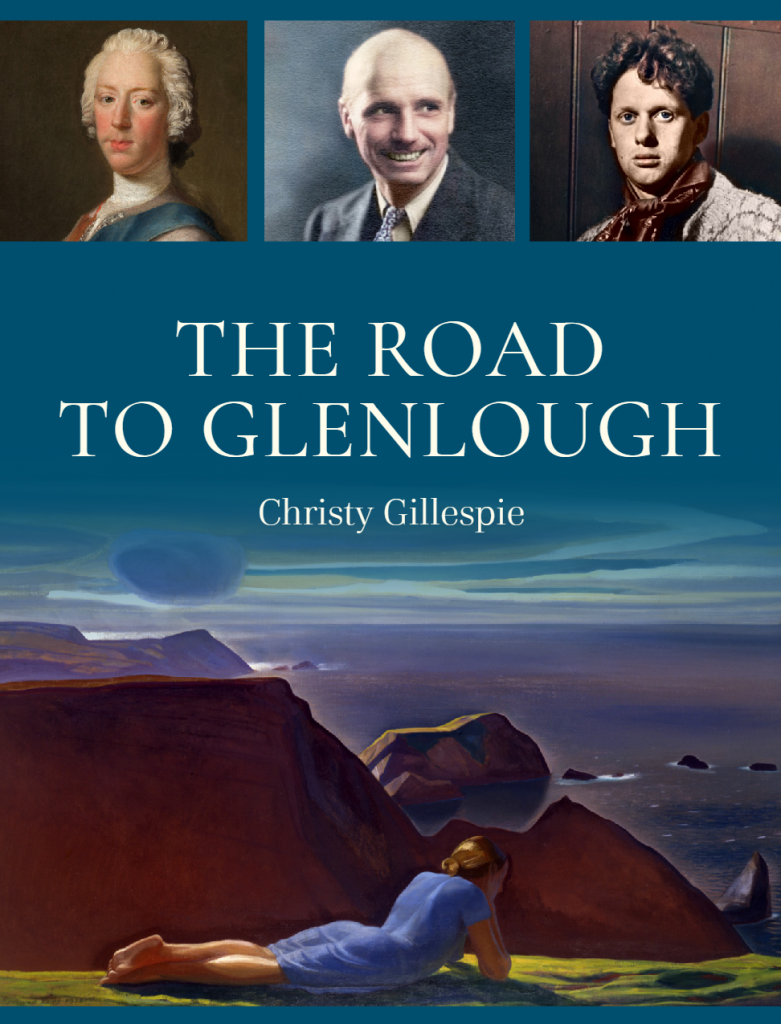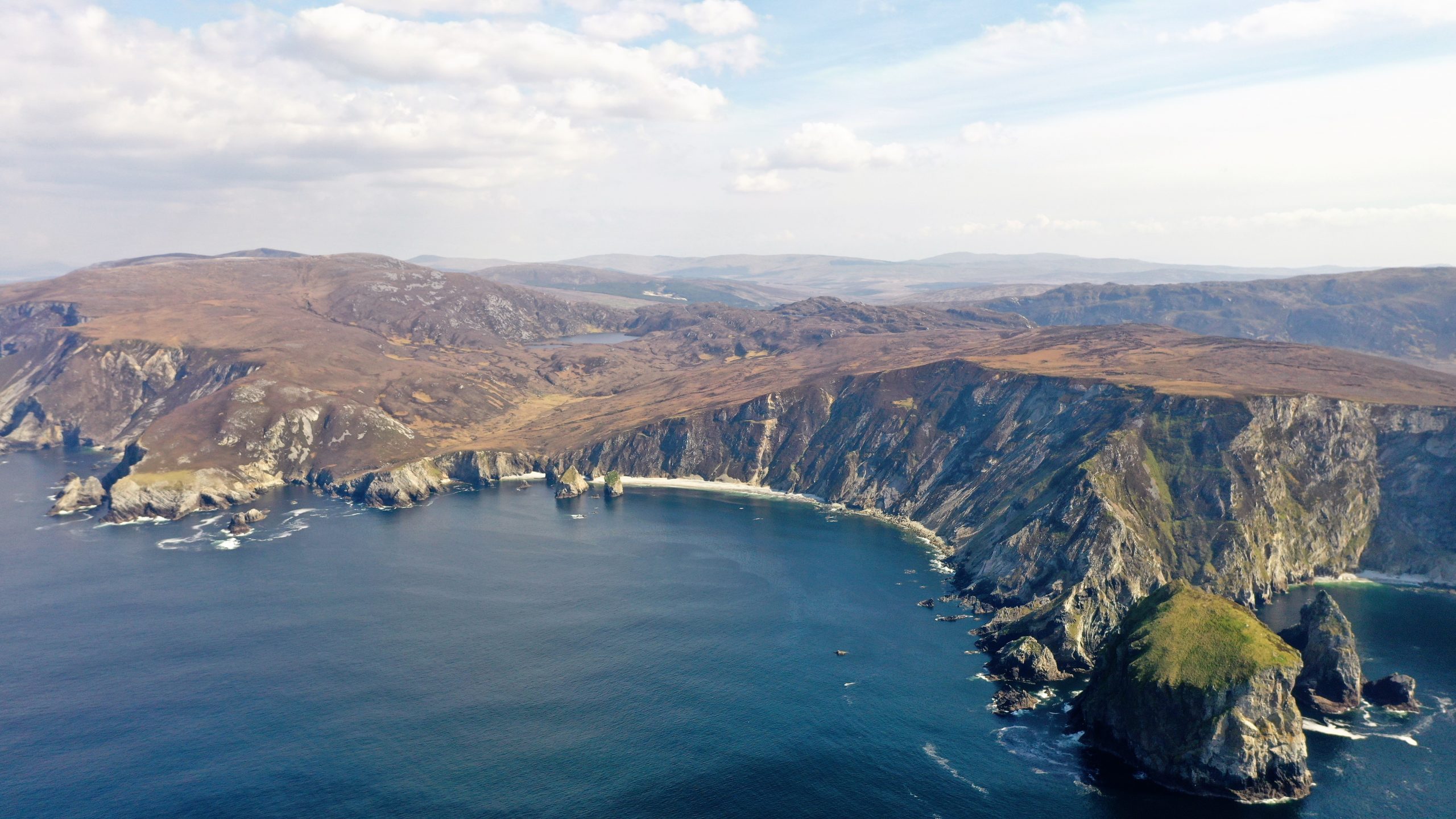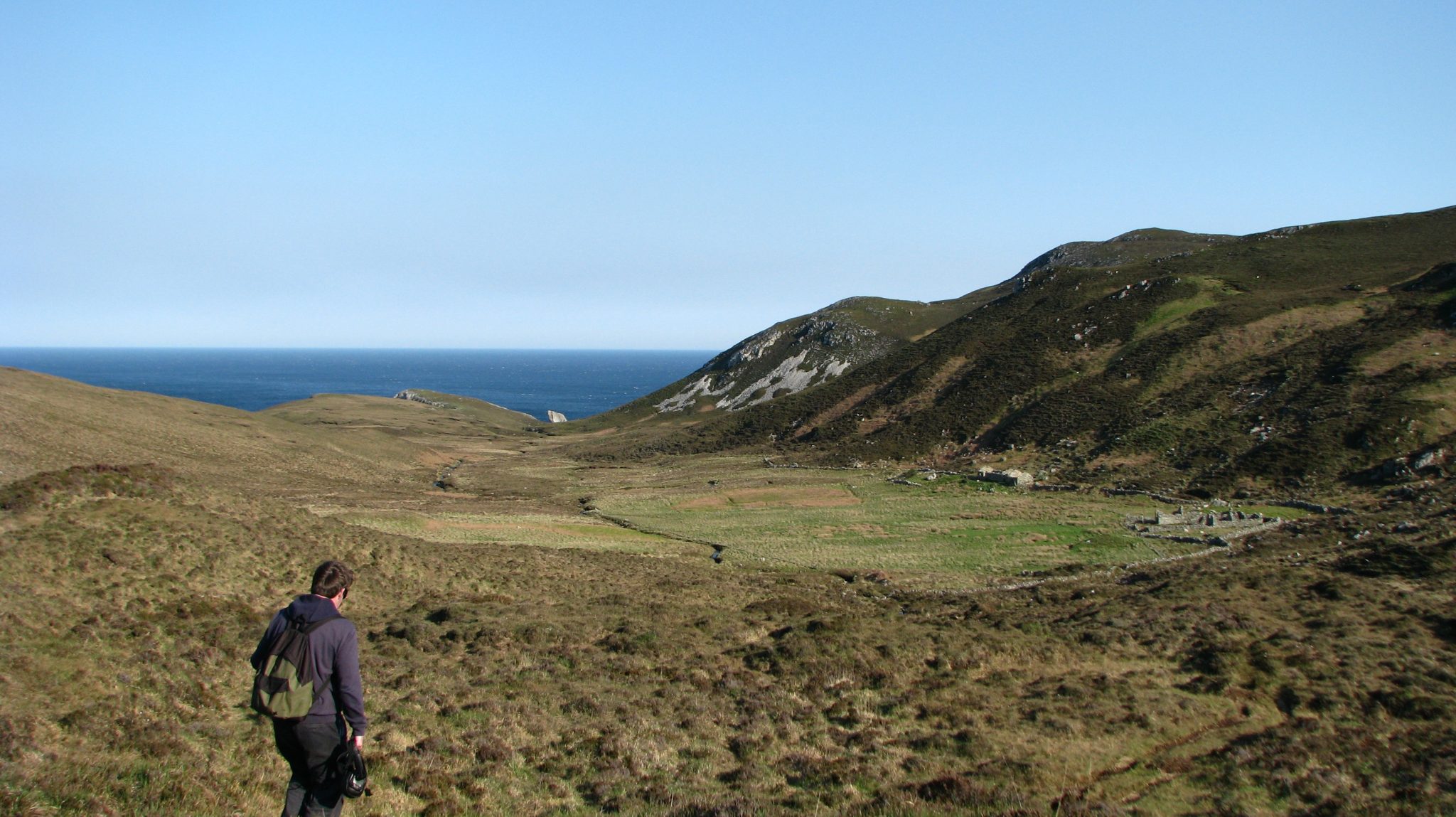The Road to Glenlough
" A story as majestic as the valley"
“I will not follow where the path may lead, but I will go where there is no path and I will leave a trail.”
In the poem Wind-Wafted Wild Flowers by Muriel Strode

Book Summation
“I will not follow where the path may lead, but I will go where there is no path and I will leave a trail.”
[From the poem Wind-Wafted Wild Flowers by Muriel Strode]
There is no road to Glenlough, not even a well-worn path. This valley, in the highlands of south-west Donegal, is as remote and monumental as it is enchantingly beautiful. It is a place that has attracted a number of notable visitors. These include American artist and illustrator Rockwell Kent, Welsh poet Dylan Thomas and, if strong local tradition is to be believed, Prince Charles Edward Stuart who sought refuge there as he waited for a French ship to bring him back to the safety of mainland Europe after his failed uprising in Britain.
But it is not just the famous that have a narrative worth relating. The truly heroic aspect of any account of Glenlough rests with the people who lived and breathed it.
In the life span of this valley, its interaction with humans has been but a heartbeat, yet it is a pulse that has been recorded assiduously through the written word, in paintings, drawings and many photographs. It is a legacy that has left us with a permanent record of a life that is no more and yet has had immortality conferred upon it.
This lavishly illustrated volume brings its storied past back into focus once more.

be part of the story
The Road to Glenlough
“This is the greatest Irish story never told.”
There is no road to Glenlough, not even a well-worn path. This valley, in the highlands of south-west Donegal, is as remote and monumental as it is enchantingly beautiful. It is a place that has attracted a number of notable visitors. These include American artist and illustrator Rockwell Kent, Welsh poet Dylan Thomas and, if strong local tradition is to be believed, Prince Charles Edward Stuart who sought refuge there as he waited for a French ship to bring him back to the safety of mainland Europe after his failed uprising in Britain.
Rich In History
July 7, 2021
“In Glenlough was everything; and still – by the vastness of the scene, by its prevailing quietness no more than by the occasional roar of the surf along the shore, by its solitude no less than in the natures of the few human beings who ever came that way – there was that Presence. Surely the very littleness of the one room ruin of an ancient house that came to so content us throughout the months we lived there was of itself a symbol of our reverence. One whispers in a church: if one could make a whisper visible it would be, in Glenlough, that house.”

The road to glenlough
The Timeline

A McGinley family move into Glenlough Valley and become its first permanent residents
A stranger and his servant, believed by locals to be Bonnie Prince Charlie, is found hiding out in Glenlough by the Glen Herd. They spend a month in Glencolmcille parish before they are brought away to safety by a French ship from the natural harbour at the valley’s base now known as Prince Charlie’s Cove.
Following the Dombrain report, this stretch of coast becomes one of the most carefully policed in the British Isles. As a result, the lucrative smuggling of tobacco from the continent, which centred on the natural harbour of Poll an Uisce or Prince Charlie’s Cove, comes to an end.
Owner Henry McGinley and his wife Margaret die within a few months of each other, aged 94 and 89 respectively, and their share of the valley then reverts to a relation, James McGinley of Port.
The Sydney ship founders on The Sturrall promontory south of Glenlough during a storm while carrying timber from Canada to Scotland. Ony two survive out of a crew of 21.
James McGinley’s daughter Catherine (Kitty) gets married to John Heekin and they build a cottage in the valley. They go on to have 12 children there.
The body of sub-lieutenant Thomas Guppy washes up on the Claddagh Mór beach. He had been on watch when the Wasp gunboat foundered on the cliffs below Tory lighthouse with the loss of fifty-two. Only five survived the tragedy.
Seventeen-year-old John Heekin is drowned after going for a swim in Lough an Aifrinn lake.
On May Day, The Heekins leave Glenlough for a new farm in Malinmore and put the valley up for sale.
It is finally bought by Dan Ward who has returned from New Zealand after ten years. He and his wife Rose move into the Heekin cottage and live there for the next thirty years.
Rockwell Kent and his second wife Frances arrive there on an extended honeymoon looking for a place to stay. Kent converts a cow byre and they live there for the next four months where the artist completes a large number of art works.
Kent’s eldest son Rockwell Kent III or ‘Rocky’ lands into Glenlough for the summer in his father’s place.
Dylan Thomas arrives accompanied by literary agent Geoffrey Grigson. Although Grigson departs after a fortnight, The poet elects to stay on in order to complete his second collection of poems simply titled Twenty-five poems.
Dan and Rose finally decide to move out of their valley as they are getting too old to carry on with that type of remote living. Dan lets Kent know of his intentions and the artist jumps at the chance of possibly purchasing it. However, the State Department have other ideas and refuse him his passport and so all the plans come to nothing.
Dan and Rose leave Glenlough and move to Meenacharvey.
The valley is finally sold to Rose’s four nephews, The Heekins from Stranagartan.
Dylan Thomas dies in New York.
Kent begins his legal battle for The Right to Travel
Kent wins his travel appeal in the Supreme Court. He immediately returns to Glencolmcille for a week’s visit before travelling on to the Soviet Union to witness his major exhibition there.
Rose Ward dies
Kent is awarded the Lenin Peace Prize
Rockwell Kent dies.
Mark Heekin dies suddenly and the rest of his brothers stop staying out in Glenlough, farming it remotely instead.
The Road to Glenlough book is published.

Read The Reviews
Testimonials
What People Are Saying
Gillespie recounts the story of Glenlough through detailed yet pacey narrative, accounts of the people who have given the valley such a rich history. A great read complimented with beautiful images and artwork relevant to each chapter.
Imagine the harsh landscape of a windswept valley … imagine being the only couple inhabiting this wild beautiful place … When we walk today in summer warmth from Glencolumbkille to Port and on to the deserted village of Glenlough we can easily forget the challenges people faced all those years ago in this inhospitable place. Imagine then the arrival of Rockwell Kent, the American artist and photographer … the rather convincing research that points to this same valley harbouring Bonnie Prince Charlie … and the presence of the great Poet Dylan Thomas … All of these accounts interwoven with the real story of the people who struggled to survive and flourish on the barren stony infertile land of this haunting place and you have the heart of this magnificent book by #ChristyGillespie. As for the pictorial record … words fail me! Our heritage and history … our people … our struggles … indeed the romance and magic, combine to make this book very extraordinary indeed... If those ruins could only speak!

Bought my copy yesterday in the Folk village (Margaret had reserved it for me). Jonathan and l drove to Port, parked looking out to sea and dived into it. I can only say how thrilled we are that this quality of documentation is happening. it’s so precious. ‘Our’ valley is truly wonderful.

As I said before, it is a remarkable work of scholarship, and now that I’ve read it, I’m more convinced than ever that it will garner critical acclaim at home and abroad. Christy has been Jesuitical in his research and fact-gathering and still manages to make it a fascinatingly enjoyable read, rather than an academic tome to be consigned to the dusty shells of university libraries. It is so readable for an academic treatise and notwithstanding the fact that Bonnie Prince Charlie, Rockwell Kent and Dylan Thomas are the three central characters, it is Glenlough that commands the centre ground and the narrative.

Well, my book has arrived and I have brought it up to my mum's house (Kitty, Annie's daughter) to let her spend some time enjoying it. I wanted to tell you our first impression is "WOW!". What an absolutely beautiful book! The photos and colours immediately catch the eye and my wee mum is totally engrossed in it, reading bits and studying photos and reminiscing about times in the area. We are absolutely delighted to read it. I have a feeling we might be fighting over it here! Mum is definitely getting first chance to enjoy it.

Ádh mór leis an leabhar. I’ve only read about Rockwell’s time in Ireland yet as I am waiting for eye surgery. Here with the book in front of me reading about my parents and grandparents (with yours truly mentioned) well I get a bit emotional. I only hope the next generations will value it as I do. I will be in touch again when I read it all. Míle buíochas. Saol fada agus sláinte mhaith duit fhéin agus do chlann.

Ordered your book and it just arrived in Alaska. What a beautiful book. Began a long, slow enjoyable read – like savouring special high-quality meal with a vintage wine. grandparents (with yours truly mentioned) well I get a bit emotional. I only hope the next generations will value it as I do. I will be in touch again when I read it all. Míle buíochas. Saol fada agus sláinte mhaith duit fhéin agus do chlann.

Thank you for telling this story with care and kindness. It will stand like a sea stack as a witness to the mighty people who went to live in inhospitable yet stunning surroundings. We are a softer breed and we’ve conceded much. This book praises the singlemindedness of our ancestors and their kindness in making room in the valley for strangers without a hint of concern for how it might go down among the neighbours in the next valley.

Mr Lewis is the compiler of the three-hour video on the life of Rockwell Kent. It is BEAUTIFUL! The pages I looked at were STUNNING. What a wonderful achievement, Christy! You have run a dozen marathons to get this project done—a testament to your love of Glenlough and Donegal and your appreciation and understanding of our very flawed but brilliant Mr. Kent. The book is really magnificent! It is a masterpiece, make no mistake!

And, it does work; over the course of 650 pages and 900 illustrations, Gillespie delves into the valley’s history, culture and local economy including wool and weaving, fishing, peat and turf, and the illicit accounts of tobacco smuggling and poteen production––all through the eye and paintbrush of the omnipresent Rockwell Kent.

Your book is a great work. That's wonderful. Each page, each painting thrills me. I may be an artist in your eyes but you are brilliant. Extraordinary.... There are so many pages to look at. I think your book will become my bible, and in the evening, before I sleep, I will travel the Glenlough road.

I’m currently reading a magisterial book by Christy Gillespie about famous visitors to the isolated valley of Glen Lough in Donegal. I visited there in 2014 for my own book on the Wild Atlantic Way and wrote about Dylan Thomas staying there in 1935. The book, The Road to Glen Lough, captures the spirit of the place with outstanding reproductive colour illustrations and astonishing research. The curious side is that there is no road to Glen Lough, nor even a path, and getting there involves a two-hour slog across moorland."

I should tell you that I gave the 2nd copy of your book that I bought to Cathal Ó Searcaigh as a birthday present. He was delighted with it, praising the book as a major Donegal publication – apart from anything else! He told me he read it in full immediately… I share Cathal’s view. It is a beautiful – and major publication.”
